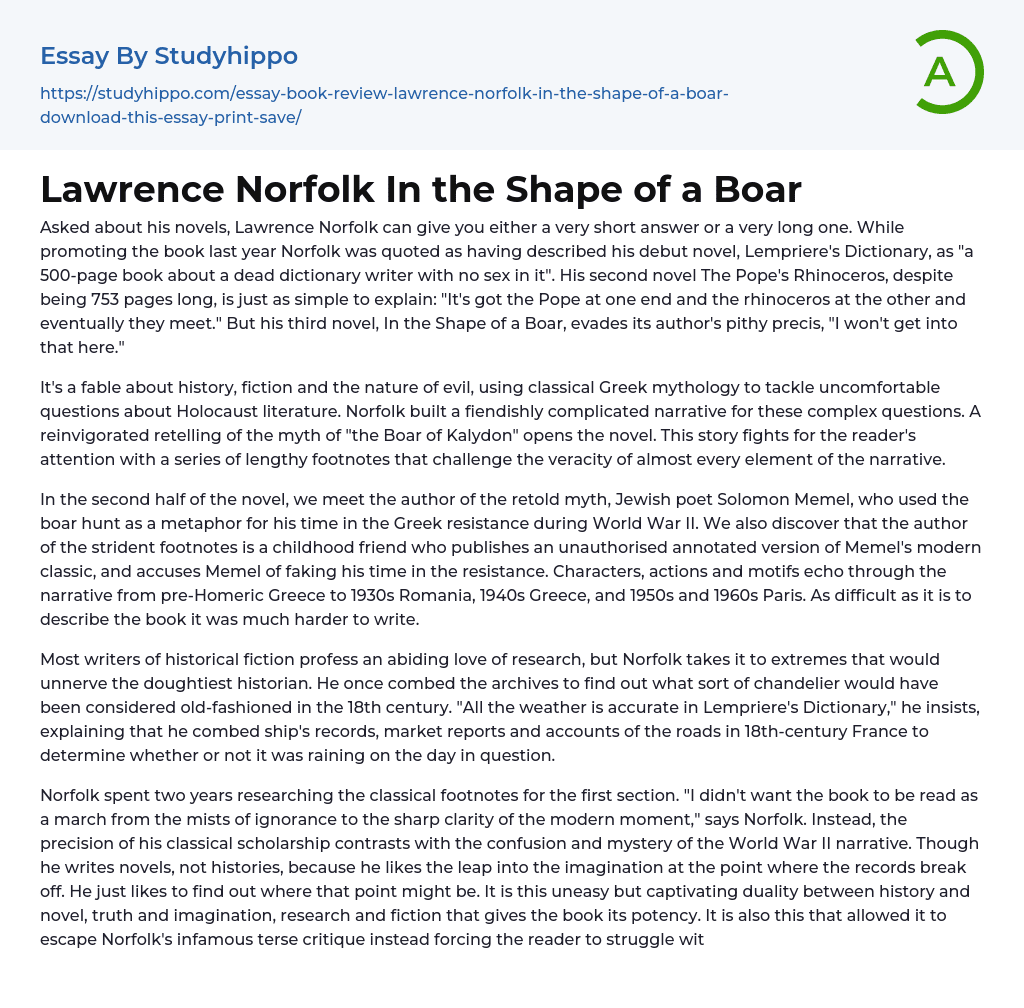Lawrence Norfolk, when asked about his novels, has two distinct ways of answering. When promoting his debut novel, Lempriere's Dictionary, he famously summarized it as "a 500-page book about a dead dictionary writer with no sex in it." Similarly, his second novel, The Pope's Rhinoceros, can be succinctly described as "It's got the Pope at one end and the rhinoceros at the other and eventually they meet," despite its considerable length of 753 pages. However, Norfolk chooses not to provide a brief summary for his third novel, In the Shape of a Boar, stating "I won't get into that here."
In this novel, Norfolk explores themes of history, fiction, and the nature of evil by incorporating classical Greek mythology and addressing uncomfortable questions about Holocaust literature. He has constructed a highly intricate narrative to tackle these complex ideas. The novel
...opens with a reimagined version of the myth of "the Boar of Kalydon," which competes for the reader's attention with an array of extensive footnotes that challenge the authenticity of nearly every aspect of the story.
The second half of the novel introduces Solomon Memel, a Jewish poet who retells a myth using a boar hunt as a metaphor for his experiences in the Greek resistance during World War II. Additionally, we learn that the author of the passionate footnotes is a childhood friend who publishes an unauthorized annotated edition of Memel's contemporary classic. This friend accuses Memel of fabricating his time in the resistance. Throughout the narrative, characters, actions, and motifs resonate from pre-Homeric Greece to 1930s Romania, 1940s Greece, and 1950s-1960s Paris. The book's description is challenging, and writing it was even more arduous.
Norfolk's dedication to research in historical fiction surpasses that of most writers. He goes to great lengths, even intimidating seasoned historians. An example of his extreme research is when he meticulously searched through archives to discover which style of chandelier would have been considered out of fashion during the 18th century. He asserts that every detail in his work is accurate, citing his exhaustive combing through ship's records, market reports, and accounts of French roads from the 18th century to ascertain whether it rained on the specific day in question.
Norfolk dedicated two years to researching the classical footnotes for the initial segment. According to Norfolk, "I did not want the book to be perceived as a progression from ignorance to the clarity of the present era." Norfolk's expertise in classical studies provides a sharp contrast to the perplexity and enigma of the World War II narrative. Even though Norfolk primarily writes novels rather than history, he relishes in the imaginative realm where historical records cease. Discovering where that point lies is a pursuit he enjoys. The book's power lies in the precarious yet captivating interplay between history and fiction, truth and imagination, research and storytelling. As a result, it defies Norfolk's notorious succinct critique and compels readers to grapple with its distinctive literary identity.
- Nineteen Eighty-Four essays
- Maus essays
- Allegory essays
- Alliteration essays
- Comedy essays
- Comic book essays
- Drama essays
- Dystopia essays
- Fairy Tale essays
- Fantasy essays
- Fiction essays
- Ghost essays
- Gothic Fiction essays
- Gothic Literature essays
- Irony essays
- Legend essays
- Memoir essays
- Novel essays
- Poetry essays
- Satire essays
- Science Fiction essays
- Short Story essays
- The western essays
- Tragedy essays
- Witchcraft essays
- John Locke essays
- 9/11 essays
- A Good Teacher essays
- A Healthy Diet essays
- A Modest Proposal essays
- A&P essays
- Academic Achievement essays
- Achievement essays
- Achieving goals essays
- Admission essays
- Advantages And Disadvantages Of Internet essays
- Alcoholic drinks essays
- Ammonia essays
- Analytical essays
- Ancient Olympic Games essays
- APA essays
- Arabian Peninsula essays
- Argument essays
- Argumentative essays
- Art essays
- Atlantic Ocean essays
- Auto-ethnography essays
- Autobiography essays
- Ballad essays
- Batman essays


Unfortunately copying the content is not possible
Tell us your email address and we’ll send this sample there.
By continuing, you agree to our Terms and Conditions.


